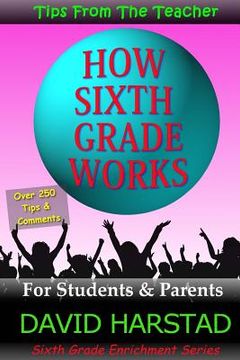Reseña del libro "How Sixth Grade Works: Tips From The Teacher (en Inglés)"
Sixth grade is your year! It's time to put good use to all those years of show-and-tell, playing in the sandbox, and tasting crayons. You already know what to do, now get a little inside teacher information from the guy who calls a dead shark hanging on the wall the "class pet." This realistic, family book answers common sixth-grade questions and describes how teachers operate their classrooms. It explains why things happen and how teachers think. Most of all, it is designed to improve self-reliance and promote your future success. Writing - Impress your teacher the first day of school with the "perfect paragraph". - Use a topic sentence. - At least six words per sentence. - At least six sentences per paragraph. - No crime, violence, gore, or fluff (i.e. "The End" or "I hoped you liked my essay.") Why can't we do more fun stuff? That's the same question teachers ask each day! Here is the main reason, as you read about ancient Egyptians, wondering if they ever had water fights building those pyramids in the hot sun. Teachers spread-out "fun" things over time. How boring would it be to go to Disneyland every day and ride the same rides? Totally awesome! (Okay, bad example.) But you get the idea. With every fun activity, students want something better next time. Soon it becomes more about the activity and less about the content... Why do teachers always put me next to the bad kids? Let's start with the definition of "bad" kids. I'm not sure any student can be labeled as "bad." Your classmates work on different levels. Some watched Sesame Street when they were young and understand sharing, kindness, and cooperation better than others. I think "challenging" student is the better term to use. Every room has them, and there are about three per class (10%). It's also good to point out that someone "challenging" to you may be friendly, hardworking, and thoughtful for others. It's a matter of perception or opinion. Likewise, the teacher may also have a different opinion of who is "challenging." With that being said, yes, there are students who are difficult to work with and sit beside. So let's discuss further... How are classes determined? The goal is balance, and there are multiple factors that determine the teacher's class. It starts at the end the year, when grade-level teachers meet and discuss each student's progress. Students are placed with the teacher that best matches their learning style, while balancing boy-girl, high-low, special needs, and behaviors. The lists go to the principal for review and a couple more changes. More adjustments are made when new students enroll, right up to the first day of school. When will we ever need this in life? I always shake my head when a 12-year old thinks they already know everything - that's why we have teenagers! It starts at the state level where adults develop studies they believe will make students knowledgeable and well-balanced in life. It's the teacher's job to follow that plan and make sure students are exposed to those topics. Friends - Sixth grade is a different year when it comes to friends. Your friends may change this year, whether you like it or not. It's natural; it happens to all students, and there are a couple of reasons why... The best advice sixth-grade teachers give to students is "be a friend to everyone." The time to practice that notion is now in sixth grade. Make it a goal to say something nice to everyone in your class each week. Teachers try to do this every day. You don't have to be best friends and hang-out with everyone; just let them know you are a friendly person (I like your backpack. Did you have a good weekend? Have a great day!) You will be surprised how many students respond to you in a welcoming way and carry on the conversation.

